




Introduction to Planet Jupiter
Kids, do you know how many planets there are in our universe? Our solar system comprises a total of eight planets. From an increasing distance, the eight planets in the solar system are Mercury, Venus, Earth, Mars, Jupiter, Saturn, Uranus, and Neptune. Jupiter is the fifth closest planet to the sun, and it does not have any solid surface. Jupiter is made up of two gases, hydrogen and helium and is the giant planet in the solar system. It is the giant ball of gas in our solar system along with Saturn, Uranus and Neptune.
In this article, we will learn which is the fifth closest planet to the sun and how? Let’s read more about Jupiter.
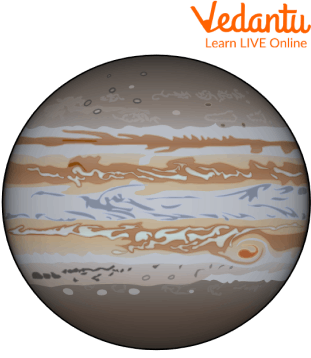
Planet Jupiter
Giant Planet Jupiter and Its Information
Jupiter is the largest planet and the fifth planet from the sun. Jupiter is the second largest object in the solar system after the Sun.
Let's learn some important information about Jupiter:
Jupiter is called a gas giant because it is so huge and is made mainly of gases- hydrogen and helium. Other gases are also found on Jupiter, like methane and ammonia.
Jupiter is made of many of the same materials as stars, and if it had been about 80 times more massive than it is, it might have become a star instead of a planet.
More than 300 earths are required to equal Jupiter's mass. At its closest point, Jupiter is 365 million miles away from earth. Jupiter is twice as massive as all of the other planets in the solar system put together.
Jupiter has a diameter of more than 88,000 miles or 14,20,00 kilometres. It is so large that if it were an enormous container, more than thirteen hundred earths could fit inside of it.
Jupiter has a great red spot. This great red spot is a giant hurricane on the surface of Jupiter. Hurricanes on earth only last for a few weeks, but in the case of Jupiter, the great red spot has been going on for years.
The mass of Jupiter is 1.898×10²⁷ kilograms. The average temperature on the planet is about minus 145 degree Celsius or minus 234 degrees Fahrenheit.
The calculated distance between Jupiter and the sun is around 778.5 million kilometres, and the speed around the sun is 13 kilometres per second or 8 miles per second.
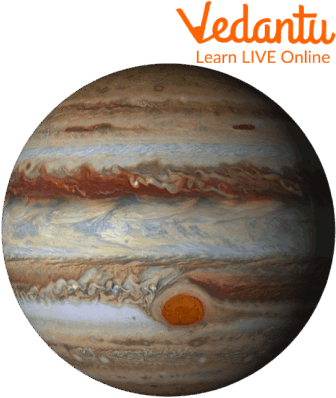
The Great Red Spot on Jupiter
How Does this Huge Planet Look?
Now that we have learned many interesting facts about Jupiter, let's see how this planet looks with a few amazing pictures taken by the satellites which studied Jupiter.
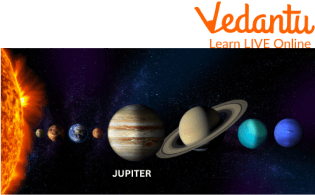
Jupiter in the Solar System
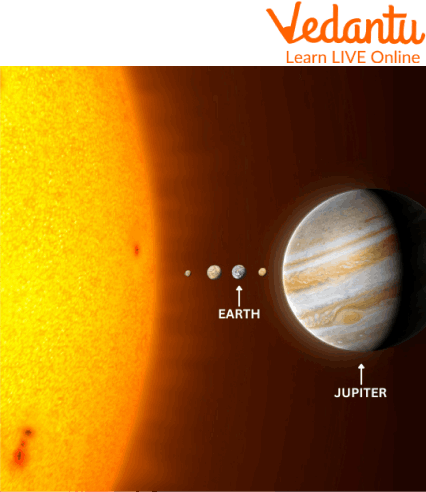
Jupiter’s Size Compared to Earth
Facts About Jupiter
Kids, in the above paragraph, we learned some information about the planet Jupiter. Let's now see some facts about this giant ball of gas- Jupiter.
Jupiter is so far from the sun that it takes more than 10 Earth years for it to travel around once. Although Jupiter's orbit is much longer than the earth's, its day is much shorter.
Jupiter rotates once every 9 hours, much faster than the earth, which rotates once every 24 hours. Also, the rotation of Jupiter is faster than any other planet in the solar system.
The spinning of Jupiter so quickly causes strong weather patterns in the clouds surrounding the planet. This makes Jupiter the stormiest planet in the universe.
The Great Red Spot was first observed by scientist Robert Hooke more than 350 years ago using a telescope. It is larger than the earth; however, recent observations have shown that this giant hurricane is shrinking and is currently at the smallest size it has ever been observed.
Jupiter has at least 67 moons. Fifty-five of these moons are very small- only a few miles or kilometres wide.
The four largest moons of Jupiter are Europa, Io, Callisto and Ganymede. These are large enough to be seen from the earth with the help of a telescope.
The moons of Jupiter were discovered by the Italian astronomer Galileo Galilei about 400 years ago. Ganymede is the largest moon of Jupiter as well as in the solar system. Ganymede is even larger than the planet Mercury.
Jupiter also has a system of thin rings around it. However, these rings are much smaller than Saturn's.
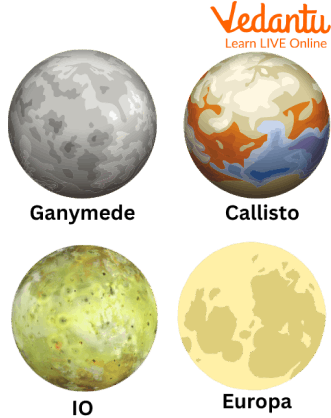
The Biggest Moons of Jupiter
Summary
Jupiter was the solar system's first planet born from primordial stardust 4.5 billion years ago. Now, we know which is the fifth closest planet to the sun and the largest planet in the solar system. Jupiter is approximately 11 earths wide and has twice the amount of mass as the other planets put together. But Jupiter has no solid surface like our planet earth has. It may not have a traditionally solid core. Instead, this giant planet has a dense, liquid centre surrounded by a worldwide ocean of hydrogen and helium gases. We also read about the giant red spot, the largest hurricane more enormous than the earth. Along with the information about Jupiter and facts about Jupiter, we also saw some exciting pictures of Jupiter planet. We hope you enjoyed reading this article, in case of any other doubts, feel free to ask in the comments.
FAQs on Jupiter
1. What powers the massive storm- the great red spot?
The energy that powers the massive hurricane of Jupiter-the great red spot comes from the core of Jupiter. The gases inside Jupiter are responsible for continuous motion, which gives rise to this hurricane.
2. Is Jupiter the brightest object in the night sky?
Jupiter is the third brightest object in the night sky- dimmer only than the Moon and Venus. Else Jupiter is the fourth brightest object in the sky after the Sun, Moon and Venus.
3. Which solar power spacecraft did NASA send to Jupiter to study the planet?
'Juno' was sent by NASA to get information about the magnetic environment, weather and formation of Jupiter. Juno reached the planet on 4th July 2016.
4. On how many planets have humans been to?
Humans have landed their spacecraft on the Moon, Venus, Jupiter, Mars and Saturn. Russia and the USA are the top countries with their spacecraft landing on each of the planets mentioned above.









